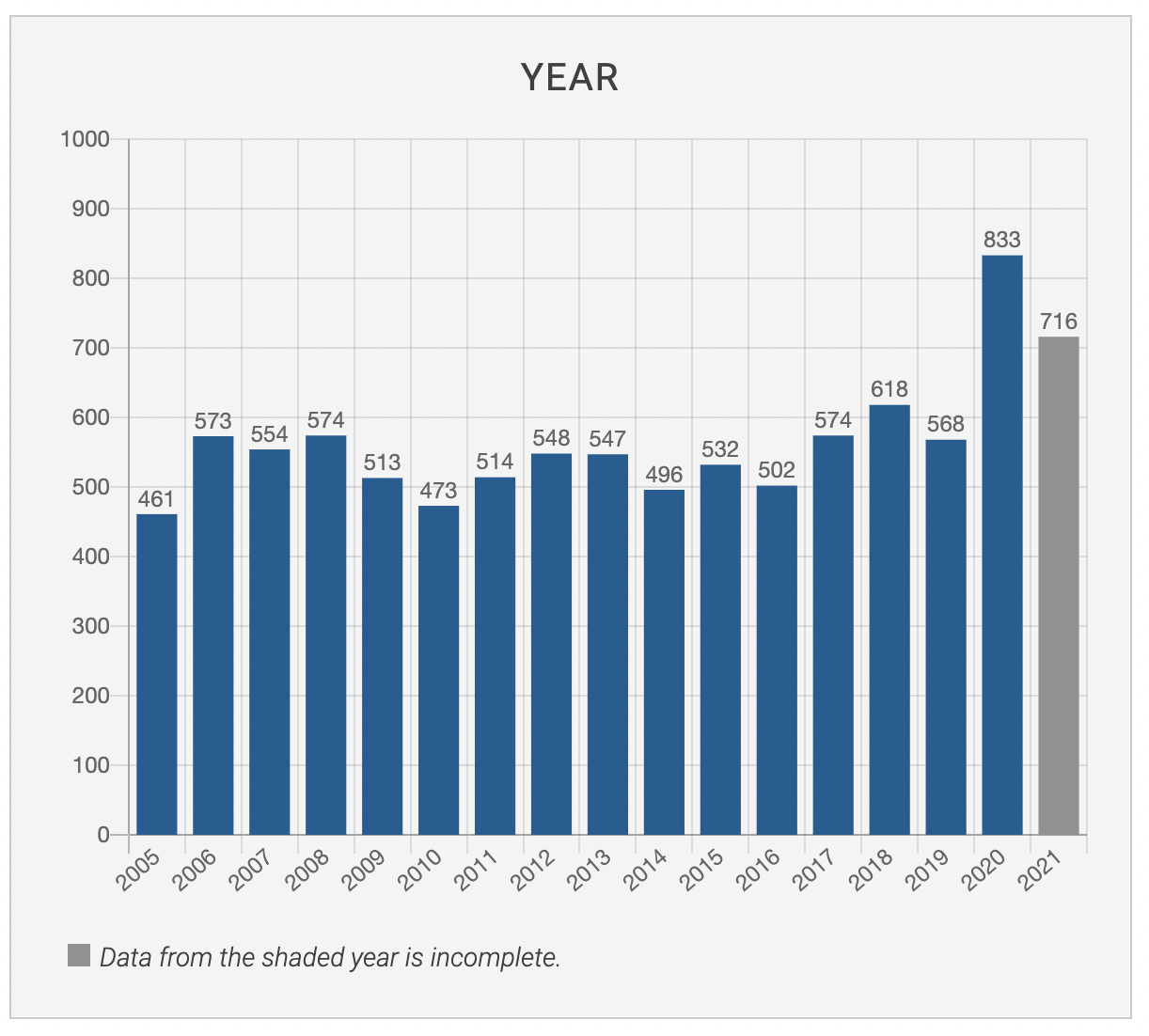TJI Blog
Where the TJI team posts blogs about our data, publications, analyses, and code.
Texas Jail Data: Phase 1
January 23, 2023A major focus at the Texas Justice Initiative is gathering and collecting data related to the Texas criminal justice system that is public but isn't made available in convenient or user-friendly ways. By making this data more easily accessible, we hope to provide context and insight on the Texas criminal justice system.
We’re excited to release a new series of data that relates to Texas’ jails. While what you see now looks less like “data” and more like a list of downloadable PDFs, organized by year and report type, we are making this information available in one place for the first time. This set of reports is an important first step towards building a tool that will allow users to interact with the jail data in the future.
Texas jails are required to report the data in our collection to the Texas Commission on Jail Standards, which oversees the facilities. Data contained in these reports provide a glimpse of who is being incarcerated in our jails and what happens inside of them during the course of a month. Population reports total the number of individuals held in each county, and immigration detainer reports show how many of those individuals are held on federal immigration holds, and the associated costs. Another report on pregnancies shows how many individuals are pregnant in jail each month, and serious incident reports summarize the total numbers of several types of incidents that can occur in a jail every month.
Typically, the Texas Commission on Jail Standards posts many of these reports on its website, although the publication of these reports stopped “temporarily,” TCJS told us last fall. The Serious Incident Reports in our collection were only made available via TJI’s open records requests.
Collecting these reports is vital to building the interactive tool we envision, and we decided to make them available on our website, even in their original form. Our volunteers will continue to architect a system that automatically scrapes these reports, and also connects these data sets in various visuals. If you’re interested in joining our team or providing funding to help us progress, please email: eva.ruth@texasjusticeinitiative.org.
2021 Deaths in Custody decline from previous year
May 24, 2022The good news*: the number of people who died in the custody of Texas law enforcement went down in 2021 after peaking the previous year.
The bad news: 2021's total — 906 deaths, according to reports filed with the state of Texas through May 1, 2022 — was still higher than every other year but 2020.
Deaths in custody of law enforcement, including anything from a deadly shooting by a law enforcement officer or an overdose in the back of a patrol car to a death by suicide or medical cause in a prison cell, must be reported to the state of Texas within 30 days of occurring. Based on those reports, which TJI tracks every month, there were an average of 677 Texas deaths in custody from 2010 to 2019. Then, due undoubtedly in part to the 2019 coronavirus, deaths in custody rose nearly 45% higher than the prior 10-year average before dropping slightly in 2021.
The leading manner of death in 2021 continues to be of causes deemed “natural,” though the percentage of deaths by natural causes was fewer than in 2020 and for 2010 - 2019. The percentages of deaths due to “other” causes and “accidental” causes were slightly higher in 2021 than in 2020 and for 2010 - 2019, while deaths due to “homicide” were slightly lower. As in previous years, the highest concentration of custodial deaths in Texas took place among individuals over the age of 60.
* Good/bad news labels based on assumption that reducing the number of deaths that occur in the custody of Texas law enforcement is a positive thing
COVID-19 drives spike in deaths in Texas prisons and jails in 2020
December 22, 2021
According to custodial death data, 2020 was the deadliest year on record for people who were incarcerated in Texas prisons and jails (see graph above). At least 830 individuals died in Texas prisons and jails, an increase of 46% over the previous year (2019), based on reports filed with the Texas Office of the Attorney General. This increase was largely driven by the coronavirus, which – agencies self-reported – killed at least 278 people in prisons and jails last year.
Broken out on its own, COVID-19 was the second-highest cause of death in jails and prisons, accounting for 34% of 2020 deaths, behind all other natural causes/illnesses at 50%. Excluding COVID-19 fatalities, deaths from natural causes in 2020 were consistent with previous years. Historically, natural causes account for more than three quarters of deaths in jails and prisons. Between prisons and jails, prisons saw both the highest number of deaths overall (84%) and the highest concentration (92%) of COVID-19 deaths. Among incarcerated individuals over the age of 50, COVID-19 accounted for at least 40% of deaths.
As the COVID-19 pandemic took hold in the U.S., there was a brief acknowledgement of the unsanitary and cramped conditions – which are also a breeding ground for the novel coronavirus – characteristic of U.S. detention centers. States across the country dramatically downsized their incarcerated population and granted compassionate release to those already infected with (or more likely to die from) COVID-19. However, in Texas, explicit policies to reduce populations during the pandemic were few and far between, according to the Prison Policy Initiative.
The data on conditions in Texas facilities was often inaccurate and unreliable. The tracking dashboard maintained by the Texas Department of Criminal Justice occasionally had disclaimers stating that the data was unreliable. TDCJ also published announcements when incarcerated individuals and employees died of COVID-19, but those posts have become sporadic at best. Additionally, agencies also took longer to file their custodial death reports, some showing up months after the 30-day deadline as required by state law. Lastly, changing, incomplete or vague reporting of the precise cause of death made it difficult for watchdogs, like TJI, to capture all COVID-related deaths in their reporting. For example, during the pandemic, TJI started tracking deaths that are reportedly caused by “bronchopneumonia,” a cause that didn’t exist much on reports before 2020.
Beyond being a tragic example of the deadliness of COVID-19, the spike in deaths within Texas jails and prisons in 2020 raises questions about the conditions that make those facilities uniquely vulnerable to outbreaks. The lack of disinfectants and poor medical care, in conjunction with cramped conditions and the negative impacts of living in a high stress environment, all contribute to making jails and prisons inherently unsafe and, in 2020, increasingly deadly spaces. Worst of all, this trend doesn’t seem to be slowing down: 2021 has already exceeded 2019 totals by 6%, with 600 deaths reported as of the end of October.
NOTE: For the purposes of this analysis, custodial death reports were cross-referenced against manually-gathered reports from media and other law enforcement sources to determine whether a death was due to COVID-19. Data was pulled in the first week of November 2021.
COVID-19 data scant during Delta variant wave
October 4, 2021For months, Texas has been battling the highly contagious Delta strain of the coronavirus. After a surge in the beginning of 2021, deaths due to COVID-19 were somewhat low in the spring – but then they started to climb.
And despite the rise in cases undoubtedly affecting individuals incarcerated in prisons and jails, who are particularly vulnerable to die from COVID-19, the actual reporting of infections and deaths in Texas lockups has mostly stopped.
For many months since the start of the pandemic, the Texas Commission on Jail Standards, which is responsible for ensuring county jails operate within state law, had asked jails to file daily reports on whether (and how many) infections were detected among staff and incarcerated individuals. However, that practice ended in June, when TCJS informed jails that the reports were no longer required.
Throughout the pandemic, the Texas Department of Criminal Justice, which oversees prisons, periodically announced deaths of employees and incarcerated individuals online. Yet no deaths of incarcerated individuals have been announced since mid-June.
Amid this dearth of data on COVID-19 deaths in Texas lockups, since mid-June, more than 13,400 Texans have died from the coronavirus, according to state data. Also since mid-June, the pandemic has killed at least 31 people who worked for county sheriff's offices and TDCJ, according to media sources, agencies and the Officer Down Memorial Page.
So just how many people have died of COVID-19 in Texas prisons and jails during this latest deadly wave? At least 18 – according to custodial death reports that agencies are required by state law to file within 30 days of a death. But the true number? It will take months to know for sure.

Join Our Team
July 27, 2021TJI functions thanks to talented volunteers who work collaboratively to build and maintain our website and data tools. Our team meets weekly – remotely and, when volunteers in Austin are comfortable doing so again, in-person – and keep in touch during the week on Slack and email. We are lucky to have consistently had amazing volunteers, and we are looking to add a few people to the mix.
Our volunteers have a variety of skillsets, backgrounds and levels of experience. Frequently, we learn from and teach each other during our weekly meetings and in one-off conversations. We'd love to welcome folks who can work on existing projects like automating our data collection processes, incorporating maps into our existing data sets and applying our new style guide to our use of colors in existing charts, and we're also looking for people to fill these new roles:
-
data visualization designer/architect for new project that incorporates several sets of data regarding populations in county jails over time;
-
data architect to coordinate with corporate volunteers on automation tool;
-
SEO and Google Analytics whiz
Does any of this sound like you? If so, please fill out this form, where you'll also find the fine print on our stack.
-